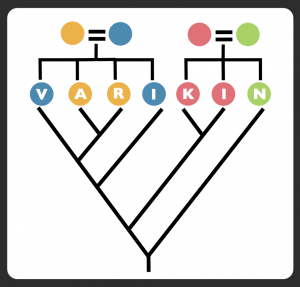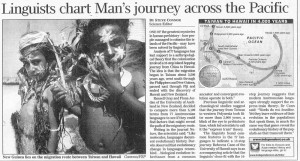Varikin: Variation in Language, Cognition and Social Norms Regarding Family

Why do human societies differ in who they class as family? How do children learn about kinship? Why do some societies classify cousins with siblings, and other groups distinguish cousins through your mum or your dad? When and how do people talk about family? Although these questions have intrigued anthropologists for over a century, they remain basically unsolved. VariKin was funded by the European Research Council and has run for from 2015-2021. Further linked activities were funded by the Leverhulme Trust and British Academy. Activities of the team of anthropologists, linguists, psychologists (and others!) included conducting fieldwork to understand how kids learn kinship, investigating how we talk about kinship in speech and text, and modelling how social norms about family evolve over time and space. The work is ongoing beyond the grant, and we welcome potential collaborators on this project, particularly those interested in children’s acquisition of kinship knowledge — please get in touch.
The Varikin-Usage subproject seeks to understand people’s use of kinship terminology by detecting patterns of usage in large collections of spoken and written language. Through an empirical corpus linguistic approach to word usage, we hope to gain insights into the kin categories that are more likely to be part of discourse, more salient for speakers, and under pressure for communicative stability or change. How do people talk about kinship? What could be driving this variation, and what do these patterns mean for language change?
The Varikin-Development subproject asks how children acquire concepts of kinship in different cultural contexts. The project focuses on Datooga-speaking children of Tanzania, using ethnographic and linguistic methods to explore how and when children experience and talk about kinship. In addition to these qualitative approaches to kinship socialisation, we designed a set of stimuli-based tasks to elicit kinship knowledge from children of different ages. We will also conduct a number of these tasks with English-speaking children in Bristol and have made the elicitation materials available for other researchers. An additional goal of the project is to survey and review the existing literature in the social sciences on how children learn about kinship and family.
The Varikin-Evolution subproject investigates the evolutionary processes underlying the transformation of kinship systems. What determines cross-cultural kinship diversity? Are there systematic processes determining how and when kinship changes occur? What are the ancestral states of kinship systems, and what does that tell us about the history of human society? We are collecting kinship data from societies around the world, which we will combine with modern phylogenetic comparative methods and cultural, linguistic, and environmental data from D-PLACE in order to infer and test cultural evolution processes.
A large part of the project has been the development of Kinbank, a global database of kinship terminologies. Click here to read more.
People:
Fiona Jordan (PI)
Péter Rácz (PDRA in Corpus Linguistics)
Alice Mitchell (PDRA in Linguistic Anthropology)
Terhi Honkola (PDRA in Evolutionary Linguistics)
Catherine Sheard / Jo Hickey-Hall (Research Support Assistants)
Sam Passmore (PhD student in Cultural Phylogenetics)
Transmission
A key mechanism driving cultural evolution is the social transmission of information. Humans learn from each other, but there are biases in this learning process that determine what we learn, and, in turn, what information we pass on to others. These biases are central to the evolution of culture. The transmission project uses a variety of accents across the UK and the USA to explore how the associated prestige of these accents affect recall of different types of information. We are using evolutionary and sociolinguistic methods to investigate how we perceive and can measure prestige, and the affect of prestige on transmission. We will be using transmission chain experiments to simulate the evolution of narratives containing multiple transmission biases and told by speakers with different accents to investigate the interaction between context and content biases. Additionally, we will be looking at linguistic accommodation in different-accented dyads to map concepts of sociolinguistic prestige onto cultural prestige.
The project team is based in the Department of Human Dimensions of Natural Resources at Colorado State University and the excd.lab at the University of Bristol. We’re generously funded by the Department of Linguistic and Cultural Evolution at the Max Planck Institute for the Science of Human History.
People:
Fiona Jordan (PI, University of Bristol)
Michael Gavin (PI, Colorado State University)
Alarna Samarasinghe (PhD student, University of Bristol)
Richard Berl (PhD, Colorado State University)
Other projects
Globalisation, adversity, and adaptation
The Department’s research themes are a perfect fit for Simon Bishop‘s project on the experience of cultural adjustment for long-term student sojourners (international students). Working from a phenomenological perspective, Simon will focus on the subjective, meaning-making processes that are missing from long-established psychological models of cultural adjustment, which are felt to be inadequate for today’s social reality as constituted by globalisation. In addition, a phenomenological perspective will also be used to address the gap between academic, institutional and ‘everyday’ discourses around culture and cultural diversity, one of the current central debates in the field of intercultural communication. Bringing these two strands together, we hope to provide a reconceptualising of cultural adjustment that will be of benefit wherever sojourner wellbeing is an issue, e.g. university policy, corporate training or individual self-help.
Evolution of semantic systems
How does meaning expressed in words vary across languages and change over time? Together with colleagues Asifa Majid and Michael Dunn, in this large cross-cultural project we investigate how the semantic systems of different domains vary over the Indo-European language family. We study colour, body-parts, objects and spatial relations with a set of naming elicitation tasks, and together with our collaborators we have data from over 1000 speakers across 50+ languages. Funded by the Max-Planck Society through the Evolutionary Processes Group at MPI Psycholinguistics, more details are available here: www.mpi.nl/eoss.
Pacific prehistory and cultural evolution
 Fiona’s first venture into cultural phylogenetics was the construction of Austronesian language trees together with Russell Gray. We used these trees to test competing hypotheses about Neolithic human settlement in the Pacific. Currently Fiona is working with Ethan Cochrane at the University of Auckland to understand the evolution of Polynesian agricultural techniques. Other current projects include understanding the amazingly complex counting and number systems in the region as culturally evolved (with Andrea Bender and Seighard Beller), and work on the evolution of Austronesian land tenure (Geoff Kushnick and Russell Gray). This last topic has evolved into a broader global investigation of the Geography and Evolution of Land Tenure Systems together with (many) colleagues on the NSF-funded GELTS project (NSF-1519987). Other work includes Vishnupriya Kolipakam‘s PhD project to test models of how sex-specific postmarital residence patterns may have impacted on genetic diversity in the Pacific, a topic which has big implications for our understanding of prehistory in the region.
Fiona’s first venture into cultural phylogenetics was the construction of Austronesian language trees together with Russell Gray. We used these trees to test competing hypotheses about Neolithic human settlement in the Pacific. Currently Fiona is working with Ethan Cochrane at the University of Auckland to understand the evolution of Polynesian agricultural techniques. Other current projects include understanding the amazingly complex counting and number systems in the region as culturally evolved (with Andrea Bender and Seighard Beller), and work on the evolution of Austronesian land tenure (Geoff Kushnick and Russell Gray). This last topic has evolved into a broader global investigation of the Geography and Evolution of Land Tenure Systems together with (many) colleagues on the NSF-funded GELTS project (NSF-1519987). Other work includes Vishnupriya Kolipakam‘s PhD project to test models of how sex-specific postmarital residence patterns may have impacted on genetic diversity in the Pacific, a topic which has big implications for our understanding of prehistory in the region.
Cultural transmission and diversity at the macroevolutionary level
Formalising ideas about how populations come to share similar cultural profiles is central to comparative anthropology: it is at the heart of trying to control for the non-independence of related societies (Galton’s Problem). Currently in the group, Cecilia Quaintrell‘s ethnomusicological project examines the structures of musical endings across 15 diverse world societies. A project with Ruth Mace used Ethnographic Atlas data on Austronesian societies to tease out phylogenetic and geographic effects on cultural similarity between different classes (economic, kinship, political) of traits. Another project (Luke Mathews, Jamie Tehrani) looked at how material culture traits such as craft techniques and traditions are transmitted: as coherent cultural packages, or as multiple independent lineages.
Biocultural adaptation
A number of past projects fall into this broad category: reconstructing the ancestral states of cognitive traits and preferences in the great apes; testing for phylogenetic signal and cultural correlations in the worldwide human sex-ratio; and explaining diversity in visual depictions of human female genitalia.